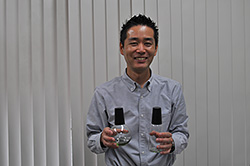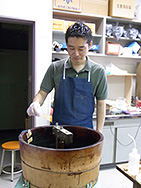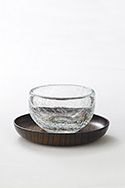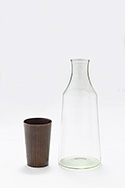Meet Japanese Companies with Quality
Long lasting luster with urushi JOBOJI URUSHI WORKSHOP
Website: JOBOJI URUSHI WORKSHOP![]()
Category: Japanese Design & Daily goods
A rich tradition born in Japan
For more than 9,000 years, Japanese craftspeople have been perfecting the art of urushi-a kind of lacquer coating made from the sap of the urushi tree. Historically, urushi has been used to coat armor, create samurai tools, and beautify and protect shrine and temple relics. Today, urushi is used for dishware and decorative crafts, and it's still used to make ceremonial items for traditional Japanese buildings. Not only does it form a beautiful and protective coating but it has natural antibacterial properties. Eighty percent of Japanese urushi comes from the town of Joboji in Iwate Prefecture in northern Japan, home to a hotbed of artisans skilled in this ancient art.

Joboji Urushi Workshop President Takuo Matsuzawa holding sake bottle sets from the new Urushito Glass line

Matsuzawa goes through the process of purifying and preparing the urushi sap
Time and patience for lasting beauty
Making urushi lacquerware is an intensive process, starting with the cultivation of urushi trees, grown in Iwate, that take 10 to 15 years to mature. After maturity, the sap can be harvested but yields only about 200 grams per tree. The harvesting and preparation of the sap is an exacting procedure with great care taken to ensure purity. The urushi is then painted on and left to dry thoroughly before the next coat can be applied. Most urushi products made at Joboji take at least seven coats.
Every day, everywhere
Matsuzawa hopes to create beautiful, useful items that can be used in everyday life but will also be a badge of Japanese culture and history. Currently, international sales account for about ten percent of the company's output, but Matsuzawa would like to widen urushi's appeal in the U.S. and Europe over the next few years. In fact, there's a precedent for international appreciation for urushi. Europeans have long been interested in urushi, having gone as far as attempting to imitate the urushi lacquering process, which became known in the 17th century as "Japanning."

A glass and lid/saucer from the Urushito Glass collaborative line

Urushito Glass angled sake bottle
Recently, Japanese urushi products have become popular in China and Hong Kong. Joboji participated in Jetro Asia Caravan in 2011, attending a home and housewares show in Shanghai that turned out interested buyers who were intrigued by the high quality of the traditionally "Made in Japan" pieces. In 2012 and 2013, Joboji attended the trade shows International Gift Fair "NY Now" in New York. And in October 2014, Joboji exhibited at the Ninohe City Fair in New York City, which showcased products from Ninohe (where Joboji town is located) in Iwate. The Urushito Glass collaboration between Joboji Urushi (Iwate) and Hagi Glass (Yamaguchi) was a highlight, as the sake flask and cup sets and lidded glasses are an exquisite accompaniment to the fine sake that has long been produced in the same area.
Website: JOBOJI URUSHI WORKSHOP![]()



